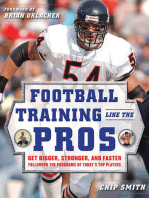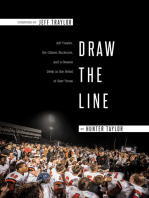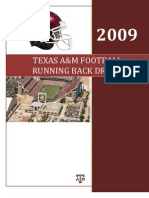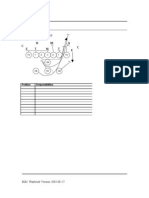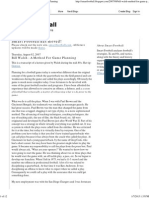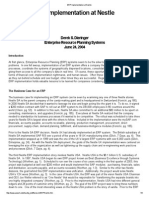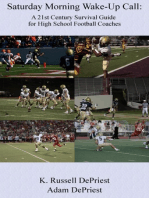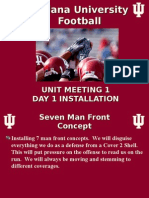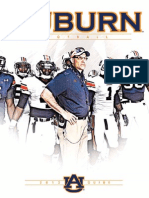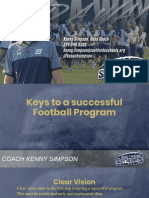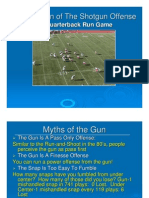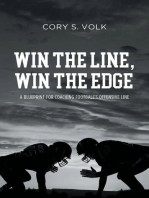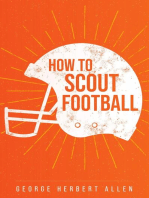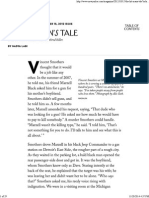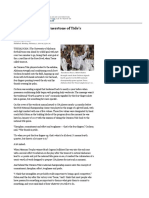Professional Documents
Culture Documents
Saban Ization
Saban Ization
Uploaded by
Les CanoOriginal Description:
Copyright
Available Formats
Share this document
Did you find this document useful?
Is this content inappropriate?
Report this DocumentCopyright:
Available Formats
Saban Ization
Saban Ization
Uploaded by
Les CanoCopyright:
Available Formats
The
Sabanization
of college
football
Story Highlights
Nick Saban has a total-control, detail-oriented, evaluation-to-graduation system
After Alabama won two titles in three years, the imitators have started to arrive
Saban's coaching tree is influencing Florida State, Texas, Tennessee and more
Nick Saban has led Alabama to two BCS titles in three years thanks to the Process, a culmination
of all he's learned in the college and NFL ranks.
Kevin C. Cox/Getty Images
This story appears in the Aug. 20, 2012 issue of Sports Illustrated. Buy the
digital version of the magazine here.
SI.com's 2012 college football preview content archive
They pulled on their garnet-and-gold polos and gathered in the ballroom at
the Hilton in Ocala, Fla., for a cocktail hour followed by a glimpse into the
future. It was May 2010, and Jimbo Fisher had been Florida State's head
coach for four months. As he looked out across the ballroom, Fisher saw
eager faces beseeching him to share his plans for restoring the Seminoles to
the national championship peak of the Bobby Bowden era. The Seminole
Boosters wanted a pep rally. Fisher gave them a sales pitch.
Fisher explained that since taking over, he had hired a nutritionist to monitor
what players ate. He had contracted a mental-conditioning coach to change
how players thought. He had inherited two strength-and-conditioning-
assistants, then hired six more and was on the verge of bringing on a
seventh to ensure that players received more individual attention in the
weight room. Fisher then asked the boosters to dig deep because he needed
more. He wanted better dorms for the players and an indoor practice facility.
Basically, he wanted everything his old boss, Nick Saban, had at Alabama.
Fisher wanted to duplicate the Process.
*****
Instead of talking about wins and championships, Saban speaks about the
Process. In its most basic form, the Process is Saban's term for
concentrating on the steps to success rather than worrying about the end
result. Instead of thinking about the scoreboard, think about dominating the
man on the opposite side of the line of scrimmage. Instead of thinking about
a conference title, think about finishing a ninth rep in the weight room.
Instead of thinking about graduating, think about writing a great paper for
Intro to Psych. Since Saban has won three of the past nine BCS titles (LSU
in 2003, Alabama in '09 and '11), the phrase has morphed into the mission
statement for Saban's program-building philosophy. After watching the Tide
coach raise all those crystal footballs, athletic directors and coaches across
the country are trying to replicate his philosophy and results. Call it the
Sabanization of college football.
"People want the blueprint," says Florida coach Will Muschamp, who was
Saban's defensive coordinator from 2002 to '04.
When the Tigers won the 2003 BCS title, Fisher ran LSU's offense. Derek
Dooley, now Tennessee's coach, ran the special teams. Today each heads a
program that has won at least one national title since 1998. The three
former LSU assistants face a steep climb back to college football's highest
echelon, and each works under the assumption that anything less than a
national championship will, in time, get him fired. All three know they were
hired to use Saban's blueprint to do what he has done at Alabama and LSU.
The three former LSU coaches aren't the only ones Sabanizing their
programs. Mark Dantonio, who worked for Saban at Michigan State from
1995 to '99, had the Spartans one win from the Rose Bowl in 2010 and '11.
Jim McElwain, who was Alabama's offensive coordinator from '08 to '11,
became the head coach at Colorado State in December. Even Texas coach
Mack Brown, whose own admired blueprint produced a 101-16 record from
'01 to '09, had Saban in mind when he brought two new assistants to Austin
after the '10 season to help the Longhorns evolve to win in a new decade.
To duplicate what Saban has done at Alabama will not be easy. Plenty of
schools have money and eye-catching facilities to dazzle recruits. But few
other schools have won as consistently as Alabama since 2008. After a
frustrating first season in Tuscaloosa -- which included several off-the-field
issues and a home loss to Louisiana-Monroe -- Saban has gone 48-6. In the
past three seasons Saban has won two titles and lost only four times.
Every few years the game becomes enamored with a system or scheme, and
it rushes to declare the birth of the sport's Next Big Thing. In 1991, Houston
quarterback David Klingler clutched a lit bundle of dynamite on the cover of
SI, suggesting the run-and-shoot would explode the old assumptions. It
never did. In 2000, Virginia Tech quarter-back Michael Vick graced SI's
cover and was featured in a story about how the dual-threat quarterback
would drive the towering drop-back passer into extinction. That never
happened either. In '08 the spread offense was all the rage, and two spread
teams -- Florida and Oklahoma -- indeed faced off for the national title.
Then, in the '09 SEC championship game, a coach beat the spread. A month
later he won his second national title and showed that a scheme is no match
for the Process.
*****
The difference between Nick Saban's system and the spread or the run-and-
shoot is that Saban's on-field schemes involve no gimmickry. He runs a 3-4
defense that utilizes zone blitzes and disguises coverages exceptionally well.
While he works mostly with the defense at practice, Saban encourages his
offensive staff to build around a large -- but not huge -- athletic line. The
quarterback need only be a competent game manager, buttressed by a fast,
hard-running ball of muscle at tailback. The line blows open holes, and the
back breaks tackles on the second level. If teams pack the box to stop the
run, the game manager throws to receivers athletic enough to exploit man-
to-man coverage. None of this is revolutionary.
While Saban has always surrounded himself with coaches whose X's and O's
acumen allows them to make the right calls on game day -- just look at his
budding coaching tree -- the true success of his system hinges on the
selection of players and the way they are trained once they arrive on
campus. That is why Saban's system can endure when schemes can't, and it
is also why several programs have made big bets that it can be duplicated.
Every player currently recruited by Alabama, Florida and Florida State gets
graded using a similar list of criteria. Coaches calculate the grades by
scoring each recruit based on three sets of criteria:
character/attitude/intelligence, position-specific critical factors and a
height/weight/speed chart. On Saban's grading scale the critical factors for a
cornerback are:
Can he judge the ball?
Can he play man-to-man?
Can he tackle?
The ideal height for a cornerback is between 6 feet and 6'2". The ideal
weight is heavier than 180 pounds. The ideal speed is less than 4.5 seconds
in the 40-yard dash. Saban is quick to point out that these are not firm
requirements. For example, Javier Arenas, who was recruited by Mike Shula
and inherited by Saban when he first came to Alabama, was only 5'9", 198
pounds, but he helped the Crimson Tide win the 2009 national title with two
picks in the championship game. Saban says he would have recruited Arenas
because he scored high on his critical factors and in the
character/attitude/intelligence department.
Those evaluation forms didn't originate with Saban. They came from Don
James, who coached Saban at Kent State and made Saban a graduate
assistant while he killed a year waiting for his wife, Terry, to graduate.
(Saban intended to go into the automotive business afterward, but once
bitten by the coaching bug, he changed course.) James, who later went on
to win six Pac-10 titles at Washington, borrowed the idea from former
Colorado coach Eddie Crowder, who forbade his assistants from watching
film of recruits and required them to grade based on in-person observation
and discussions with high school coaches. At Kent State, James tweaked the
criteria to suit his own preferences. "We were looking for guys who could
start right away," James says. "We weren't sure we were going to be around
for two or three years."
Saban borrowed another key piece of philosophy from James. When James
became the head coach at Kent State midway through Saban's career as a
defensive back, James beefed up the academic support system for his
players. "He really was into the personal, motivational, moral development,"
Saban says of James. "There was a belief there that who you are mattered
in terms of how successful you were going to be or how you played." Having
tutors and an academic adviser made staying eligible easier for the players,
and it made for fewer academic headaches for James. By the time Saban
took over at LSU, many major athletic programs had an academic-assistance
unit -- a group of advisers, counselors and tutors that support athletes -- but
he considered LSU's inadequate. He soon hired more personnel and
spearheaded the drive for a $15 million, 54,000-square-foot academic
center, which opened in 2002. When he arrived at Alabama in '07, Saban
also beefed up the academic unit. His most recent project is a $9.1 million
weight-room renovation scheduled to open in January.
While a defensive coordinator for the Cleveland Browns from 1991 to '94,
Saban worked for another critical mentor, Bill Belichick, who not only gave
Saban a master course in defensive philosophy, but also taught Saban how
to get the most out of his staff and players. Saban took note of the sign
Belichick hung in the Browns' complex. It said do your job. Saban loved it
because Belichick clearly defined the expectations for every employee in the
organization. "Everybody says, 'Be accountable,' but sometimes nobody ever
tells you exactly what the expectation is," Saban says. "Bill was good at
defining what he expected from everybody, and everybody buying in. Then
the team had a chance to flourish because of it." Every year Saban provides
everyone who touches the program with a list of responsibilities and
expectations, from defensive coordinator Kirby Smart to media-relations
director Jeff Purinton. Smart can accept the occasional tongue-lashing
because he knows what Saban expects of him. "Is he demanding? Yeah,"
Smart says. "He requires you to do your job. And I appreciate that."
Though it may come as a shock to many, Saban is more comfortable than
most of his colleagues in admitting what he doesn't know. In his quest to
train the whole player, he realizes he can't address the mental aspect of the
game as well as a sports psychiatrist. When he was head coach of the Miami
Dolphins, Saban hired Trevor Moawad, the director of performance at IMG
Academy in Bradenton, Fla., to work with his players. He now uses Moawad
as a consultant at 'Bama. While Moawad's efforts don't provide empirical
data -- a change in attitude can't be quantified like an increase in bench
press -- Saban and the players have noticed results.
In the 2010 Iron Bowl the Tide gagged away a 24-point lead in a 28-27 loss
to eventual national champion Auburn. As the game slipped away, Moawad
tried to get linebacker Dont'a Hightower to rally the defense, but Hightower
didn't feel he was the right man for the job. The following off-season
Moawad and Hightower revisited the situation, and Hightower realized he
should have done more. In 2011, Hightower and his fellow veterans
accepted their leadership roles. The defense allowed only nine touchdowns
all season and pitched a shutout against LSU in the BCS title game.
*****
As he has during past preseason camps, Saban has brought in speakers -- at
significant expense -- to highlight various lessons. Saban can preach
accountability, but the message hits harder when former basketball star
Chris Herren explains how his drug habit cost him his professional basketball
career. Saban can ask his players to stick to their guiding principles, but that
won't mean as much as it does coming from former amateur boxer Dewey
Bozella, who served 26 years in prison for a murder he didn't commit and
who, when offered his freedom in return for an admission of guilt, declined
and waited to be exonerated. "Probably one of the toughest things for these
coaches to do is convince their administrations that the investment in these
other areas is important," Moawad says. "The athletic director says, 'Well,
isn't that your job?'"
Alabama has given Saban everything he has asked for, and the school has
reaped a huge return. During Saban's tenure the Crimson Tide has
completed a massive expansion project that raised Bryant-Denny Stadium's
seating capacity from 92,000 to 101,000. According to data reported to the
U.S. Department of Education, in the last full school year before Saban
arrived (2005-06), Alabama football made $44.4 million and spent $16.7
million. In the 2010-11 school year Alabama spent $31.6 million, but it
made $76.8 million.
Can Saban's system be replicated at a school that generates about one-
tenth the revenue that Alabama generates? McElwain, the former Alabama
offensive coordinator, will soon find out, because Colorado State totaled $7.7
million in football revenue in 2010-11.
McElwain contends that some facets of the Process require little money. It
doesn't cost him anything to fill out an 18-month master calendar similar to
the one Saban keeps at Alabama. It costs Colorado State a pittance more to
print the individual job descriptions for each employee in the football
program. And it costs nothing for McElwain to draw a picture of a bus on the
grease board in the staff meeting room, on which he can write an
employee's initials inside the bus anytime that person tries to pass blame for
his own failure to someone else. Throw a co-worker under the bus and you
ride the bus of shame. "In any business organization, whether you have a
bunch of money or not much money, the people are the difference,"
McElwain says.
Saban agrees. He remembers taking over as head coach at Toledo in
December 1989 and asking for more money for academic advising for his
players. He got $25,000. "We hired one person," Saban says. "One lady. And
she did a hell of a job."
Still, the Process requires funding. Like Saban, McElwain hired Moawad to
provide mental conditioning. McElwain knew the request would seem odd,
but Rams athletic director Jack Graham approved the expense. Meanwhile,
those donors Florida State's Fisher hit up when he got the job in 2010 have
opened their wallets. The school is building a dorm that will house a large
number of football players, and Fisher -- who has moved practices to 5:30
a.m. to dodge Tallahassee's frequent afternoon thunderstorms -- proudly
notes an artist's rendering of an indoor practice facility that sits in his office.
The school will break ground on the facility in December and plans to open it
by preseason camp in '13. "Everybody thinks it's right here," Fisher says,
pointing out his window at Doak Campbell Stadium. "Or that it's the X's and
O's. That's the last part of it."
*****
Even programs that don't want to completely Sabanize have used some of
his principals. After Texas went 5-7 in a disastrous 2010 season, Brown
decided to revamp his staff. He had seen his offensive line get abused that
season, and he knew the unit needed better coaching. Still smarting from
the way Alabama's defensive line whipped the Longhorns up front in the '09
BCS title game, Brown also decided to change his defensive line coach.
Brown hired offensive line coach Stacy Searels from Georgia and swiped
defensive line coach Bo Davis from Saban's Alabama staff. Searels and Davis
knew one another well -- on Saban's '03 LSU staff, Searels coached the
offensive line, and Davis was an assistant strength coach. "They have such
cohesiveness when it comes to practice and working their guys together with
drills and trying to compete," Brown said. "I really felt like it was a win-win
for us. They've both done a remarkable job of shoring up our lines of
scrimmage in only a year."
Saban's influence has spread beyond the programs that have tried to copy
his formula. Competitors have changed their styles to compete in a league
dominated by Saban's current program and his former program. When
Saban came to LSU in 2000, Steve Spurrier's pass-happy Florida teams still
dominated the SEC. In his first two games against Spurrier, Saban lost by a
combined score of 85-24. He knew his defense would have to get better to
beat Spurrier's teams, and he set about improving that side of the ball
through recruiting. After the '01 season Spurrier left for the Washington
Redskins, and when he returned to the SEC with South Carolina in '05, he
found a league dominated by defense -- thanks to the influences of Saban
and Auburn's Tommy Tuberville. Spurrier had limited success in his first few
seasons in Columbia, but his teams began making school history after he
scrapped his beloved Fun 'n' Gun and switched to a run-heavy zone-read
offense that hogged the ball and allowed his stingy, athletic defense to rest
between possessions. Though the schemes differ, the underlying
philosophies of defensive dominance and offensive ball control are
reminiscent of Saban's model at Alabama.
Is there an approach that can beat Saban's system? The cyclical nature of
college football suggests so, but Saban's holistic Process is less susceptible
to gimmicks and schematic ingenuity. Saban finds the most talented players
with the best mental makeup; trains their mind, body and soul; and then
unleashes them. Most likely, the coach who topples Saban will have his own
process. Maybe that coach will be one of Saban's former assistants,
tweaking Saban's system to suit his own personality. Or maybe Saban will
keep on winning because he is the only one who can truly master the
Process. "You have to pay the price for success up front," Saban says.
"Everybody wants to do it. Not everybody is willing to do what they have to
do to do it."
SI.com's 2012 college football preview content archive
Read
More: http://sportsillustrated.cnn.com/2012/writers/andy_staples/08/14/sa
banization-of-college-football/index.html#ixzz2d77ImZjw
Read
More: http://sportsillustrated.cnn.com/2012/writers/andy_staples/08/14/sa
banization-of-college-football/index.html#ixzz2cvHutmgA
You might also like
- 1997 Nebraska I-Option OffenseDocument182 pages1997 Nebraska I-Option Offensejmh21100% (10)
- 2008 Alabama Defense PDFDocument430 pages2008 Alabama Defense PDFmtf1179100% (38)
- Quad Attack:: Updating Archie Cooley's Legendary Mississippi Valley State OffenseDocument13 pagesQuad Attack:: Updating Archie Cooley's Legendary Mississippi Valley State Offensebbloom50% (2)
- Football Training Like the Pros: Get Bigger, Stronger, and Faster Following the Programs of Today's Top PlayersFrom EverandFootball Training Like the Pros: Get Bigger, Stronger, and Faster Following the Programs of Today's Top PlayersNoch keine Bewertungen
- Penn State DL PhilosophyDocument25 pagesPenn State DL Philosophydaterry52Noch keine Bewertungen
- University Alabama Offense Bear Bryant WishboneDocument45 pagesUniversity Alabama Offense Bear Bryant WishboneJoby Turner100% (2)
- Draw the Line: Jeff Traylor, The Gilmer Buckeyes, And a Season Deep in the Heart of East TexasFrom EverandDraw the Line: Jeff Traylor, The Gilmer Buckeyes, And a Season Deep in the Heart of East TexasNoch keine Bewertungen
- 2009 QB ManualDocument214 pages2009 QB ManualToastysterNoch keine Bewertungen
- Don Brown Install1Document41 pagesDon Brown Install1delguapo75% (4)
- Runningback Drills TexasA MDocument18 pagesRunningback Drills TexasA MCarmy Cesaire Jr100% (5)
- MacMurray Football Pre Season WorkoutsDocument106 pagesMacMurray Football Pre Season Workoutsmartiny67Noch keine Bewertungen
- Malzhan Tulsa Playbook PDFDocument150 pagesMalzhan Tulsa Playbook PDFЕлена Нельсон100% (5)
- T Formation by Coach RolyDocument12 pagesT Formation by Coach RolyJoby Turner75% (4)
- Complete Screen Package 06Document20 pagesComplete Screen Package 06Mike100% (1)
- Smart Football - Bill Walsh - A Method For Game PlanningDocument12 pagesSmart Football - Bill Walsh - A Method For Game PlanningLes CanoNoch keine Bewertungen
- ERP Implementation at NestleDocument5 pagesERP Implementation at NestleLes Cano50% (2)
- Saturday Morning Wake-Up Call: A 21st Century Survival Guide for High School Football CoachesFrom EverandSaturday Morning Wake-Up Call: A 21st Century Survival Guide for High School Football CoachesNoch keine Bewertungen
- The SIS Football Rookie Handbook 2019: Comprehensive Scouting and Analytics GuideFrom EverandThe SIS Football Rookie Handbook 2019: Comprehensive Scouting and Analytics GuideNoch keine Bewertungen
- Jim McNally - Pass & Run Clinic NotesDocument5 pagesJim McNally - Pass & Run Clinic NotesJB WellsNoch keine Bewertungen
- Hhs LB ManualDocument27 pagesHhs LB ManualChris Henry100% (1)
- Inside The Playbook - Cover 7 BreakdownDocument3 pagesInside The Playbook - Cover 7 Breakdownwill27nsNoch keine Bewertungen
- The Complete Guide To Installing The 44 Split Defense PDFDocument171 pagesThe Complete Guide To Installing The 44 Split Defense PDFsaid100% (1)
- Cavalier Football ManualDocument13 pagesCavalier Football ManualJB WellsNoch keine Bewertungen
- TX AandM Offensiveline DrillsDocument60 pagesTX AandM Offensiveline DrillsRJCousin100% (3)
- 2019 Contextualized QuarterbackingDocument83 pages2019 Contextualized QuarterbackingTW100% (1)
- Defending The Read-OptionDocument12 pagesDefending The Read-Optioncoachmark285Noch keine Bewertungen
- Coach Niumatalolo Clinic NotesDocument12 pagesCoach Niumatalolo Clinic NotesdambugNoch keine Bewertungen
- Multiple 40 Defense - 2004Document97 pagesMultiple 40 Defense - 2004Crystal Wilcox100% (1)
- G Front Playbook SupplementDocument31 pagesG Front Playbook Supplementdambug100% (2)
- Research Walsh QB Development Guide Drills 1977Document63 pagesResearch Walsh QB Development Guide Drills 1977Michael SchearerNoch keine Bewertungen
- Hal Mumme'S Practice PlanDocument4 pagesHal Mumme'S Practice PlanMichael Schearer100% (3)
- TClemenger Northwest Football Portfolio - MannaDocument54 pagesTClemenger Northwest Football Portfolio - MannatimclemengerNoch keine Bewertungen
- Urban Meyer Bowling Green OffenseDocument40 pagesUrban Meyer Bowling Green OffenseruncodhitNoch keine Bewertungen
- 2000 Ohio State Offense - 179 PagesDocument179 pages2000 Ohio State Offense - 179 Pagesjohnwwamer100% (1)
- Defensive Line PhilosophyDocument71 pagesDefensive Line Philosophygridironmax100% (2)
- Football TemplatesDocument12 pagesFootball TemplatesWilliam Wilkie88% (8)
- The Perfect High School OffenseDocument10 pagesThe Perfect High School OffenseMark JacksonNoch keine Bewertungen
- Smart Football: Linemen SplitsDocument8 pagesSmart Football: Linemen SplitsworkinrottNoch keine Bewertungen
- Gus Mahlzan Practice OrganizationDocument4 pagesGus Mahlzan Practice OrganizationMike100% (3)
- Coaches Manual 2010Document20 pagesCoaches Manual 2010victorylakelandNoch keine Bewertungen
- Receiver BookDocument38 pagesReceiver BookMichael SchearerNoch keine Bewertungen
- Pistol Spread Option Offense: Chris Paulson & Jeff Glessner Chris Paulson & Jeff GlessnerDocument29 pagesPistol Spread Option Offense: Chris Paulson & Jeff Glessner Chris Paulson & Jeff GlessnerЕлена Нельсон100% (1)
- Msu 43Document9 pagesMsu 43jonesdw32Noch keine Bewertungen
- Spread RPO (10 Personnel)Document6 pagesSpread RPO (10 Personnel)Ray LockwoodNoch keine Bewertungen
- Defensive Line Drills 2007Document94 pagesDefensive Line Drills 2007usmcwildcats100% (1)
- WR Play - Darrell Hazzel - Ohio St.Document3 pagesWR Play - Darrell Hazzel - Ohio St.kc016Noch keine Bewertungen
- Defense 2004 Install Unit Meeting 1Document54 pagesDefense 2004 Install Unit Meeting 1martiny67Noch keine Bewertungen
- 2002WashingtonStateDocument232 pages2002WashingtonStateЕлена Нельсон100% (1)
- AD Survival Guide Final ManuscriptDocument108 pagesAD Survival Guide Final ManuscriptJB WellsNoch keine Bewertungen
- Guias 2013 AuburnDocument208 pagesGuias 2013 AuburnJj SoNoch keine Bewertungen
- Implementing The Inside Zone Running GameDocument64 pagesImplementing The Inside Zone Running Gamegrid44Noch keine Bewertungen
- Keys To A Successful Football ProgramDocument12 pagesKeys To A Successful Football ProgramJay Green0% (1)
- QB Run GameDocument42 pagesQB Run Gamecoachvint1980100% (1)
- Power Series (2nd Revision 8-29-20)Document57 pagesPower Series (2nd Revision 8-29-20)hrivas34434036Noch keine Bewertungen
- Win the Line, Win the Edge: A Blueprint for Coaching Football’s Offensive LineFrom EverandWin the Line, Win the Edge: A Blueprint for Coaching Football’s Offensive LineNoch keine Bewertungen
- Black Knights of the Hudson - History of Army Football: College Football Patriot Series, #1From EverandBlack Knights of the Hudson - History of Army Football: College Football Patriot Series, #1Noch keine Bewertungen
- How Shakespeare Paperbacks Made Me Want To Be A Writer - The New York TimesDocument1 pageHow Shakespeare Paperbacks Made Me Want To Be A Writer - The New York TimesLes CanoNoch keine Bewertungen
- Statistical Symbols & Probability Symbols (μ,σ,..Document5 pagesStatistical Symbols & Probability Symbols (μ,σ,..Les CanoNoch keine Bewertungen
- The Hit Man's TaleDocument29 pagesThe Hit Man's TaleLes CanoNoch keine Bewertungen
- Set Symbols of Set Theory (Ø, U,, ,..Document4 pagesSet Symbols of Set Theory (Ø, U,, ,..Les CanoNoch keine Bewertungen
- Sally Mann's ExposureDocument7 pagesSally Mann's ExposureLes CanoNoch keine Bewertungen
- Sally Mann's ExposureDocument7 pagesSally Mann's ExposureLes CanoNoch keine Bewertungen
- The Disturbing Photography of Sally MannDocument15 pagesThe Disturbing Photography of Sally MannLes CanoNoch keine Bewertungen
- Financial Calculators HomepageDocument1 pageFinancial Calculators HomepageLes CanoNoch keine Bewertungen
- Hacker Helped Disrupt 300 WebDocument5 pagesHacker Helped Disrupt 300 WebLes CanoNoch keine Bewertungen
- When Hospital Systems Buy Health InsurersDocument3 pagesWhen Hospital Systems Buy Health InsurersLes CanoNoch keine Bewertungen
- Fitness CrazedDocument5 pagesFitness CrazedLes CanoNoch keine Bewertungen
- Spartacus Work OutDocument4 pagesSpartacus Work OutLes CanoNoch keine Bewertungen
- When Cannabis Goes CorporateDocument9 pagesWhen Cannabis Goes CorporateLes CanoNoch keine Bewertungen
- 2012 Buffalo Bills Media GuideDocument216 pages2012 Buffalo Bills Media Guidepauld33% (3)
- Alabama Senate PollDocument2 pagesAlabama Senate Pollpgattis7719Noch keine Bewertungen
- HeismanDocument5 pagesHeismanapi-301733539Noch keine Bewertungen
- College PicksDocument1 pageCollege PicksThe Dallas Morning NewsNoch keine Bewertungen
- Cecil Hurt Special Section Page 5Document1 pageCecil Hurt Special Section Page 5USA TODAY NetworkNoch keine Bewertungen
- 2014 College Football Preview MagazineDocument153 pages2014 College Football Preview Magazineapi-241936601Noch keine Bewertungen
- The Case For The CowboysDocument1 pageThe Case For The CowboysEleven Warriors100% (1)
- Saban IzationDocument7 pagesSaban IzationLes CanoNoch keine Bewertungen
- Part 2Document14 pagesPart 2dowjones123Noch keine Bewertungen
- 2012 Auburn Football YearbookDocument212 pages2012 Auburn Football YearbookAuburnAthleticsNoch keine Bewertungen
- 2017 SEC Football Schedule GridDocument1 page2017 SEC Football Schedule GridsurintanNoch keine Bewertungen
- Power Of: SceneDocument11 pagesPower Of: Scenemabrown9Noch keine Bewertungen
- Rammer Jammer Yellow HammerDocument2 pagesRammer Jammer Yellow Hammerapi-218819851Noch keine Bewertungen
- Golden Nugget - 2014 College Football Games of The YearDocument4 pagesGolden Nugget - 2014 College Football Games of The YearMarcus DiNittoNoch keine Bewertungen
- Five Values Create Cornerstone of Tide's SuccessDocument5 pagesFive Values Create Cornerstone of Tide's Successjenkins4100% (1)
- Cecil Hurt Special Section Page 2Document1 pageCecil Hurt Special Section Page 2USA TODAY NetworkNoch keine Bewertungen
- Afca Notes 2014Document32 pagesAfca Notes 2014Paolo Borchini100% (1)
- Schedule GridDocument1 pageSchedule GridStuart ViceNoch keine Bewertungen
- Called To Coach by Bobby Bowden, An ExcerptDocument39 pagesCalled To Coach by Bobby Bowden, An ExcerptSimon and Schuster100% (2)



